USWNT World Cup Cycle Analysis
An evaluation of how the U.S. Women's National Team prepared for each World Cup dating back to 1999.
As I reflected on whether the Netflix documentary on the U.S. Women’s National Team’s performance at the 2023 FIFA Women’s World Cup rang true in terms of its title, Under Pressure: The U.S. Women’s World Cup Team, I decided to evaluate how the team was prepared for the World Cup in comparison to its predecessors by diving into the following questions:
- How were the minutes distributed during the build up to the World Cup among all field players who played during the build up?
- Were the field players prepared during the build up to the World Cup to play a specific role at the actual tournament?
- When was the core of the World Cup team - defined as all field players who started at least twice during a World Cup - identified during the build up to the tournament? How many matches did the nucleus of the team have together to build an identity, chemistry and rhythm before the World Cup?
In evaluating these questions, I intentionally took goalkeepers out of the equation to focus on field players. I also defined the build up to the World Cup as the first game following the Olympics where the coach was free to select the roster through the last sendoff match prior to the World Cup. Any post-Olympic Celebration Tour matches where the roster was mandated to be the Olympic roster by the Collective Bargaining Agreement between U.S. Soccer and the U.S. Women’s National Team Players Association were excluded. Finally, the 1991 and 1995 World Cup teams were excluded from this analysis as there were no Olympics prior to those tournaments so it wouldn’t be an apples to apples comparison.
World Cup build up dates and total matches for each edition of the team are:
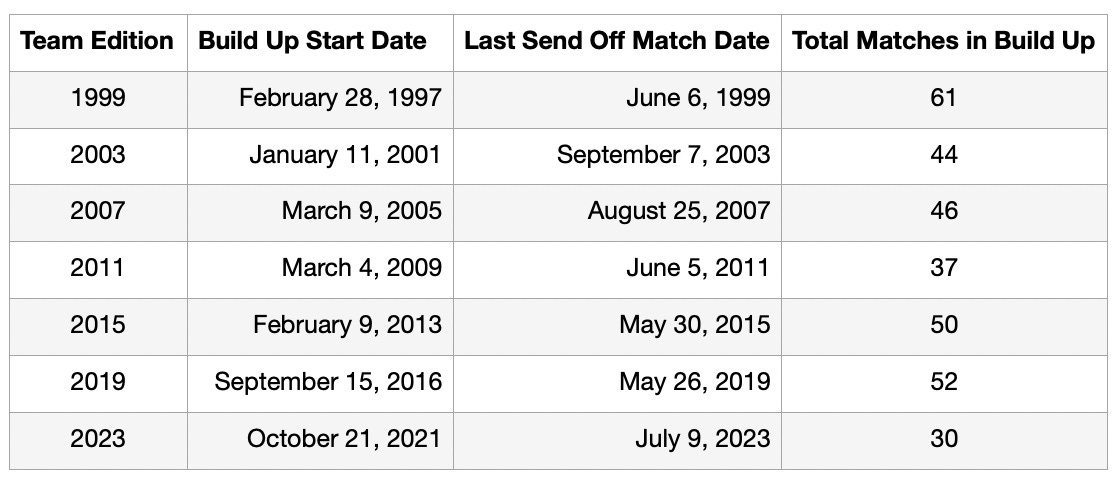
What follows are the data visualizations of the World Cup cycle I created for each edition of the team. You can jump to any of them by using these links:
- How were the minutes distributed during the cycle among all players who played during the cycle?
- Were the players prepared during the cycle to play a specific role at the World Cup?
- When was the core of the World Cup team - defined as all players who started at least twice during a World Cup - identified? How many matches did the nucleus of the team have together to build an identity, chemistry and rhythm heading into the World Cup?
I've also included a few player notes for each squad at the bottom of this post which provide additional context to these visualizations.
Finally, my review of the Netflix documentary can be found here with more commentary on the 2023 team.
Question 1:
How were the minutes distributed during the cycle among all players who played during the cycle?
To evaluate this question, I looked at how the total minutes available in the build up to the World Cup were distributed among:
- Players who started at least twice at the World Cup (Green)
- Players who came off the bench or started at most once during the World Cup (Blue)
- Players who made the roster but did not play any minutes at the World Cup (Orange)
- Players who did not make the World Cup roster (Red)
2023 World Cup Cycle || Head Coach: Vlatko Andonovski || Round of 16
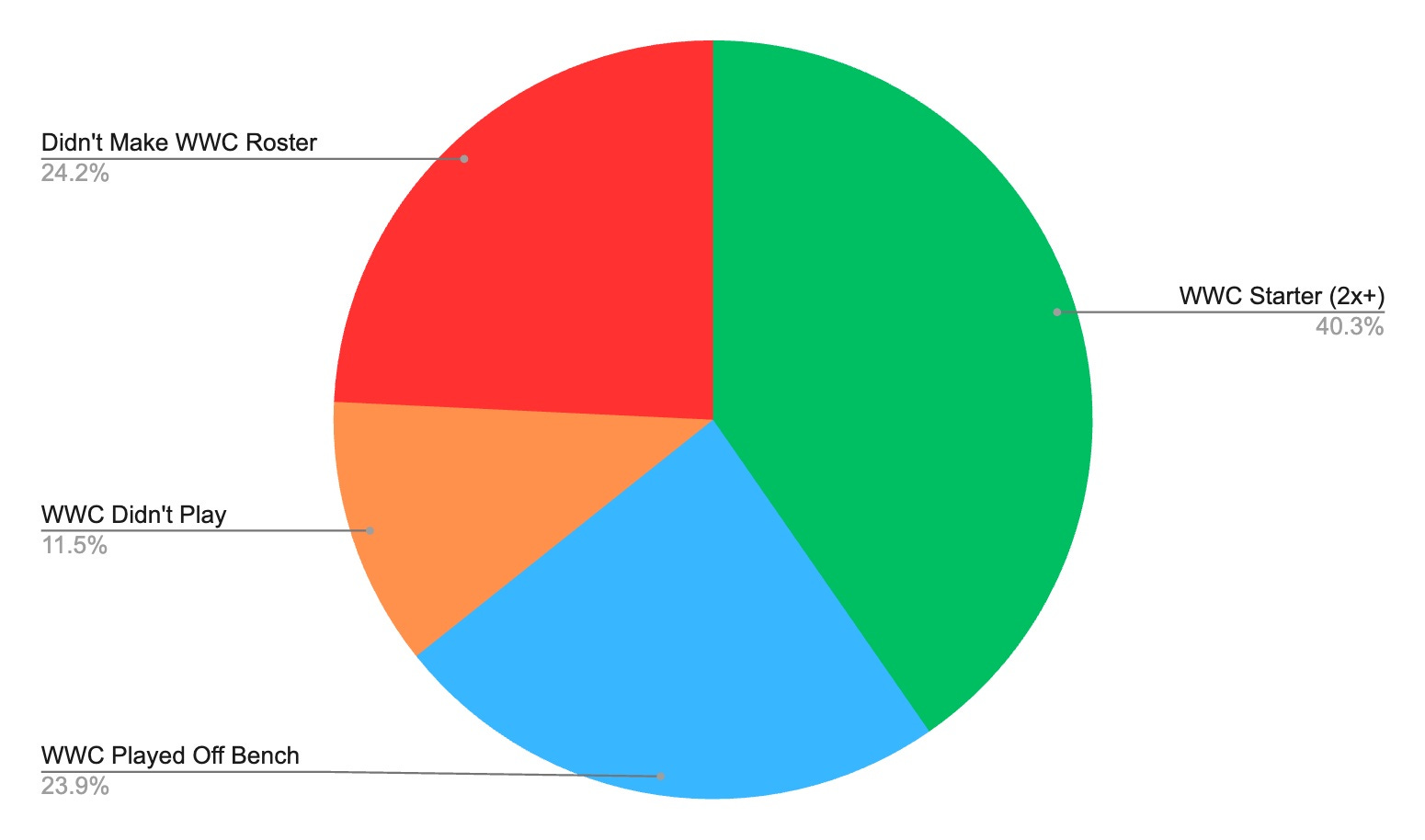
2019 World Cup Cycle || Head Coach: Jill Ellis || Champion
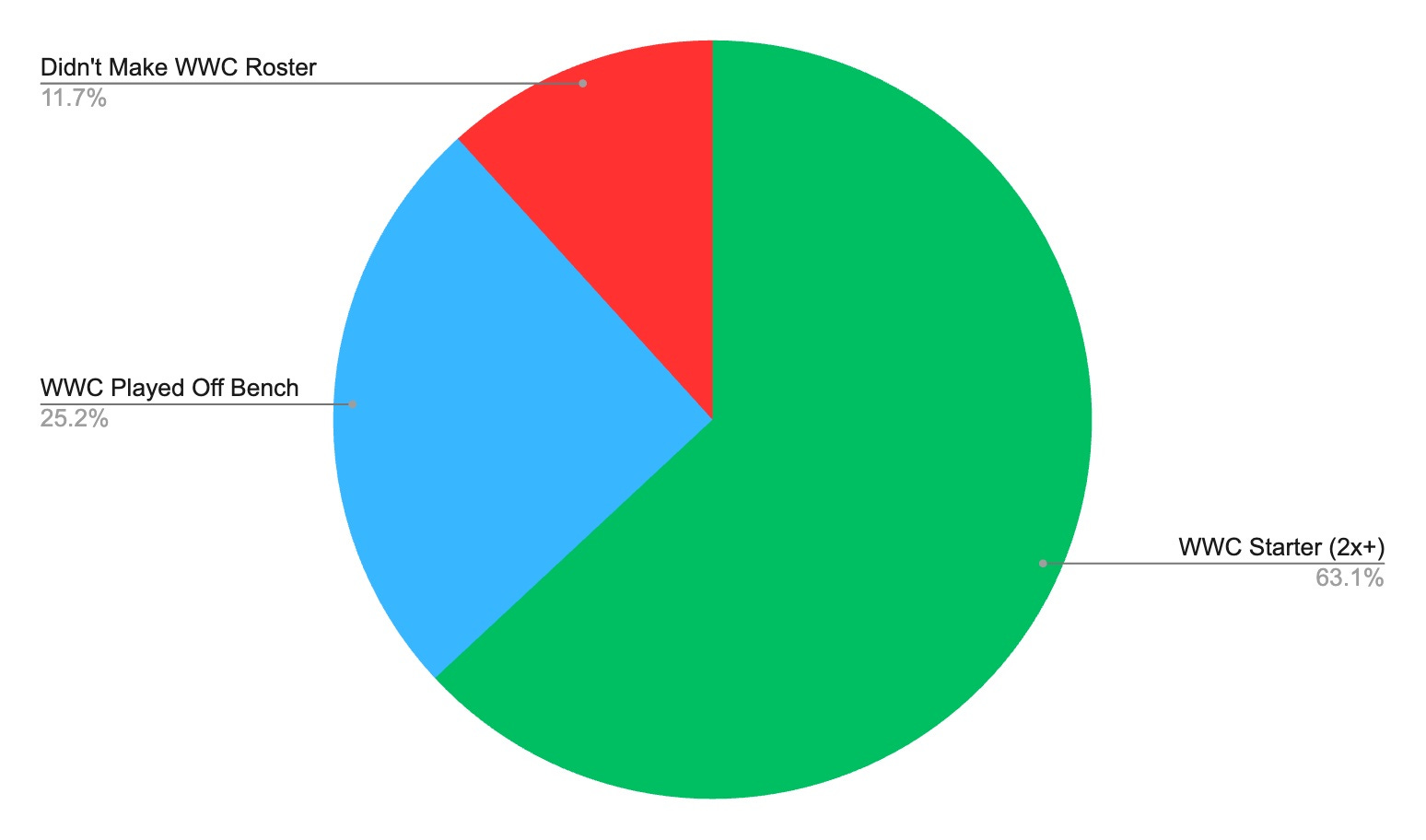
2015 World Cup Cycle || Head Coaches: Jill Ellis (April 10, 2014 onwards) & Tom Sermanni (2013 - April 6, 2014) || Champion
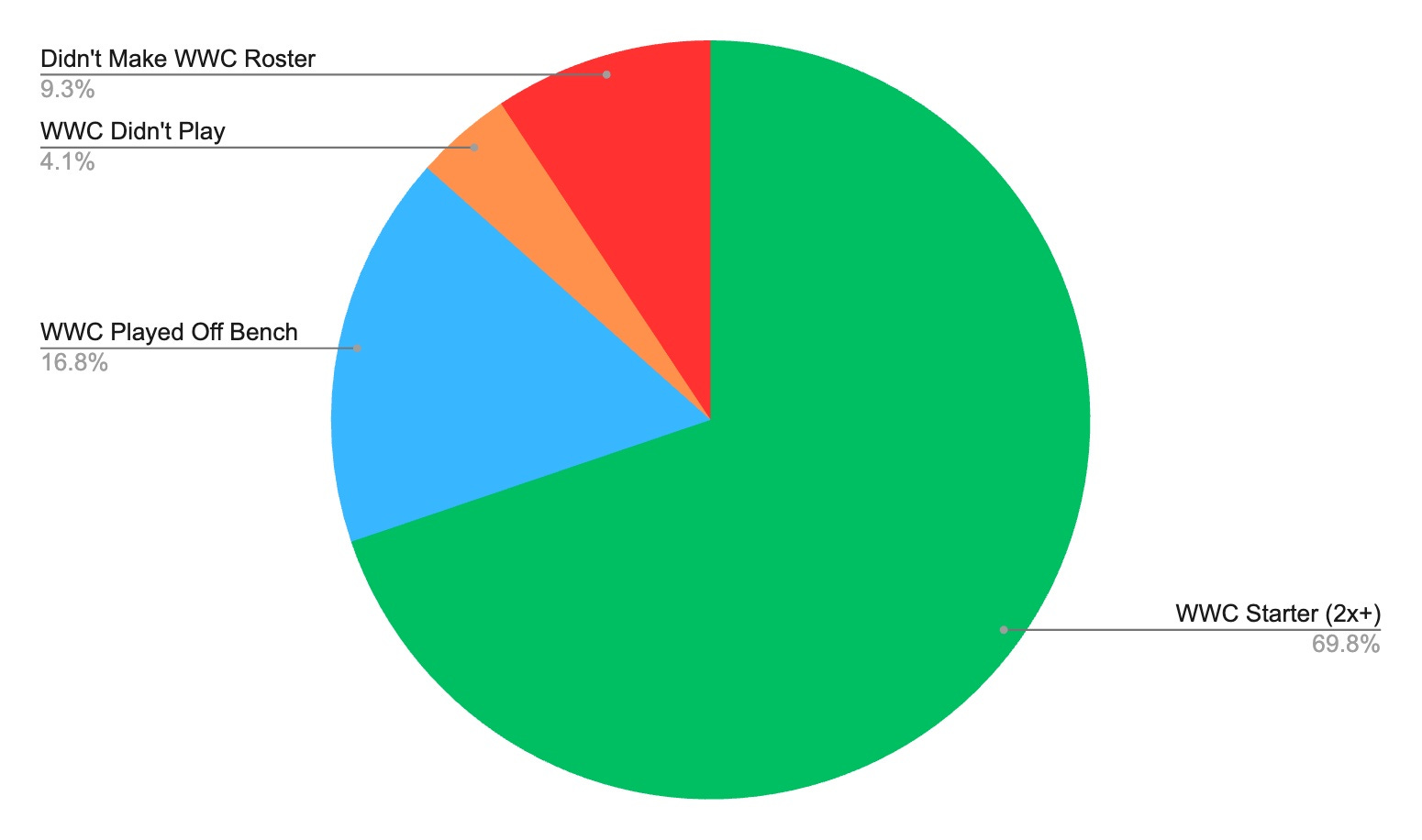
2011 World Cup Cycle || Head Coach: Pia Sundhage || Runner-Up
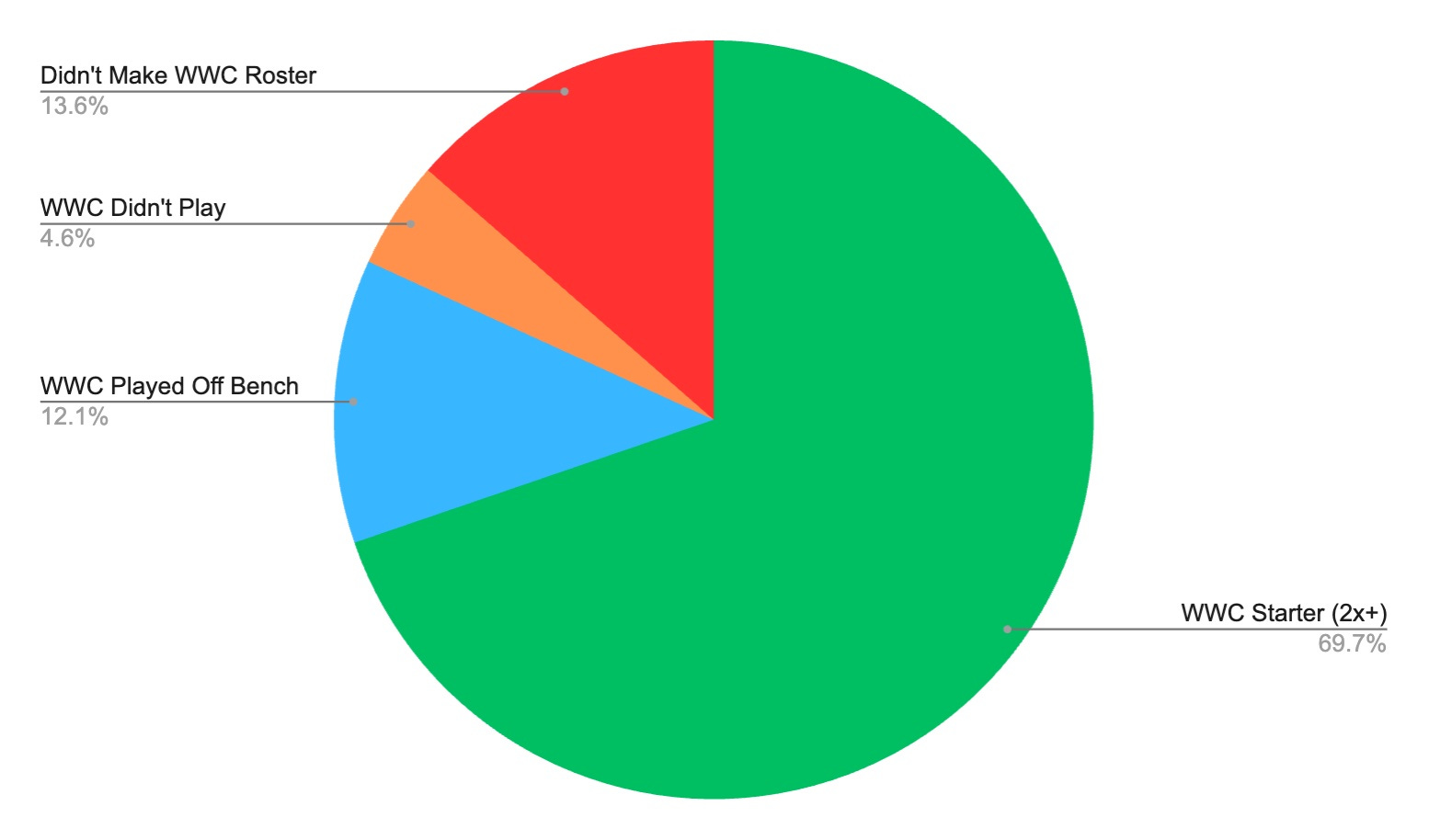
2007 World Cup Cycle || Head Coach: Greg Ryan || 3rd Place
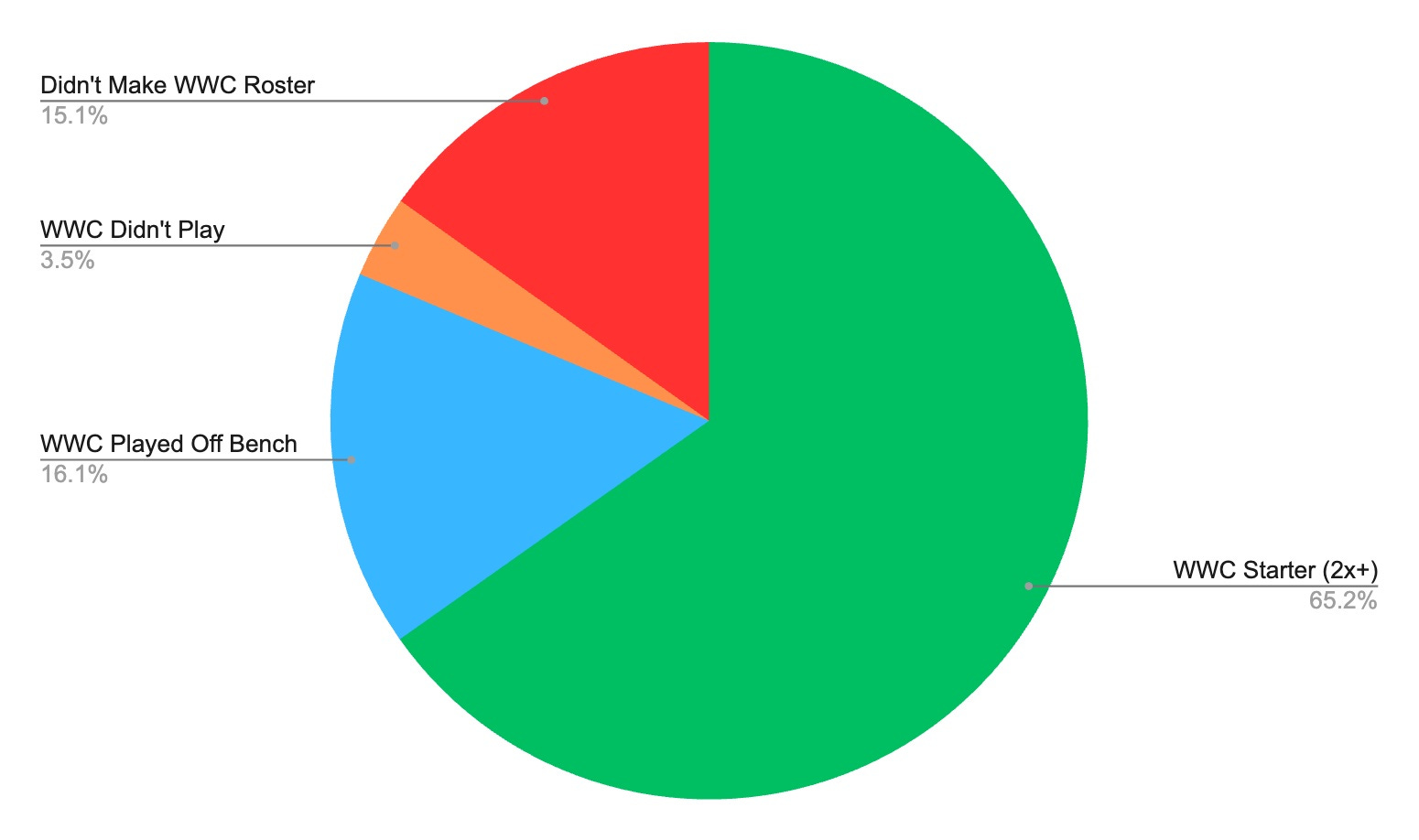
2003 World Cup Cycle || Head Coach: April Heinrichs || 3rd Place
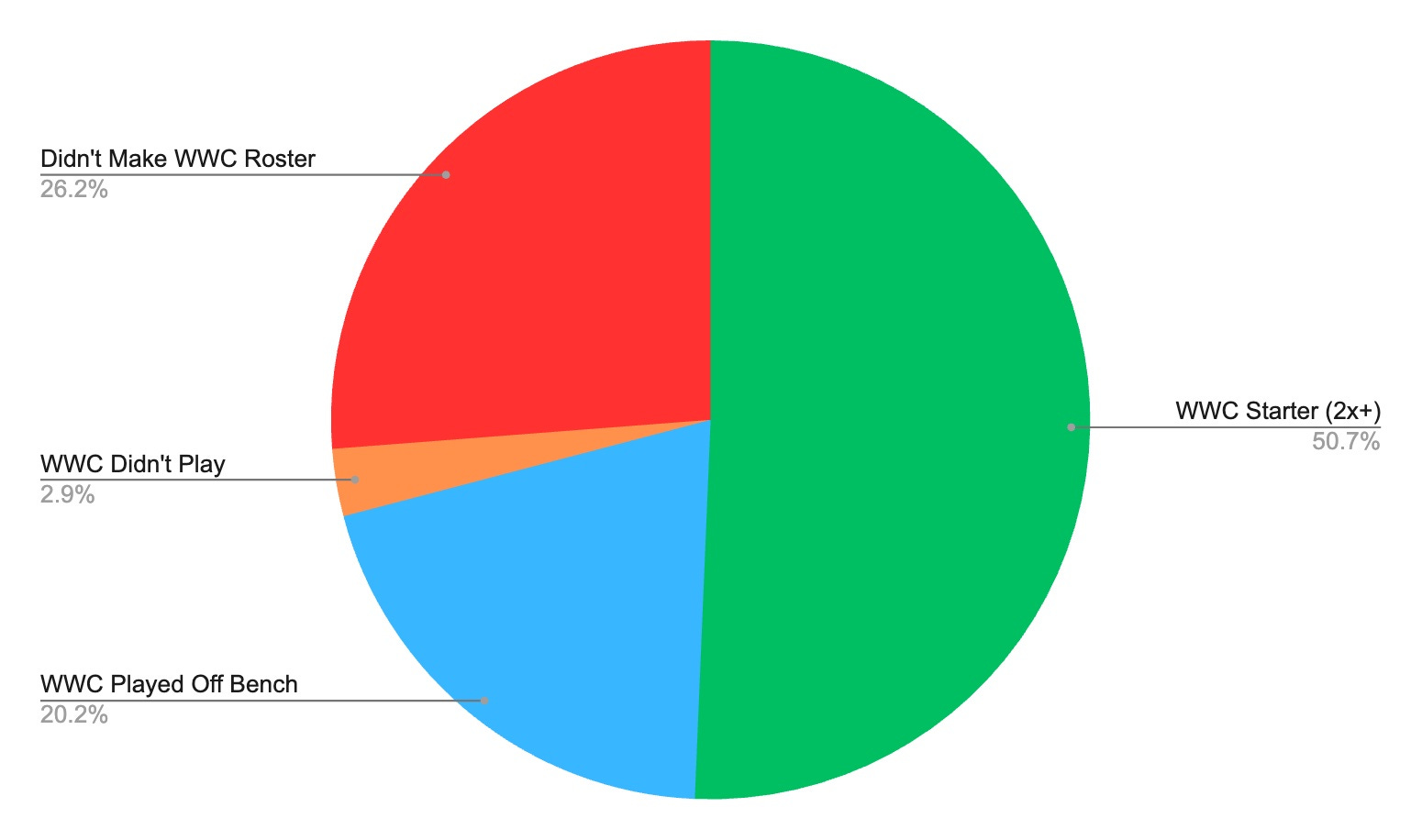
1999 World Cup Cycle || Head Coach: Tony DiCicco || Champion
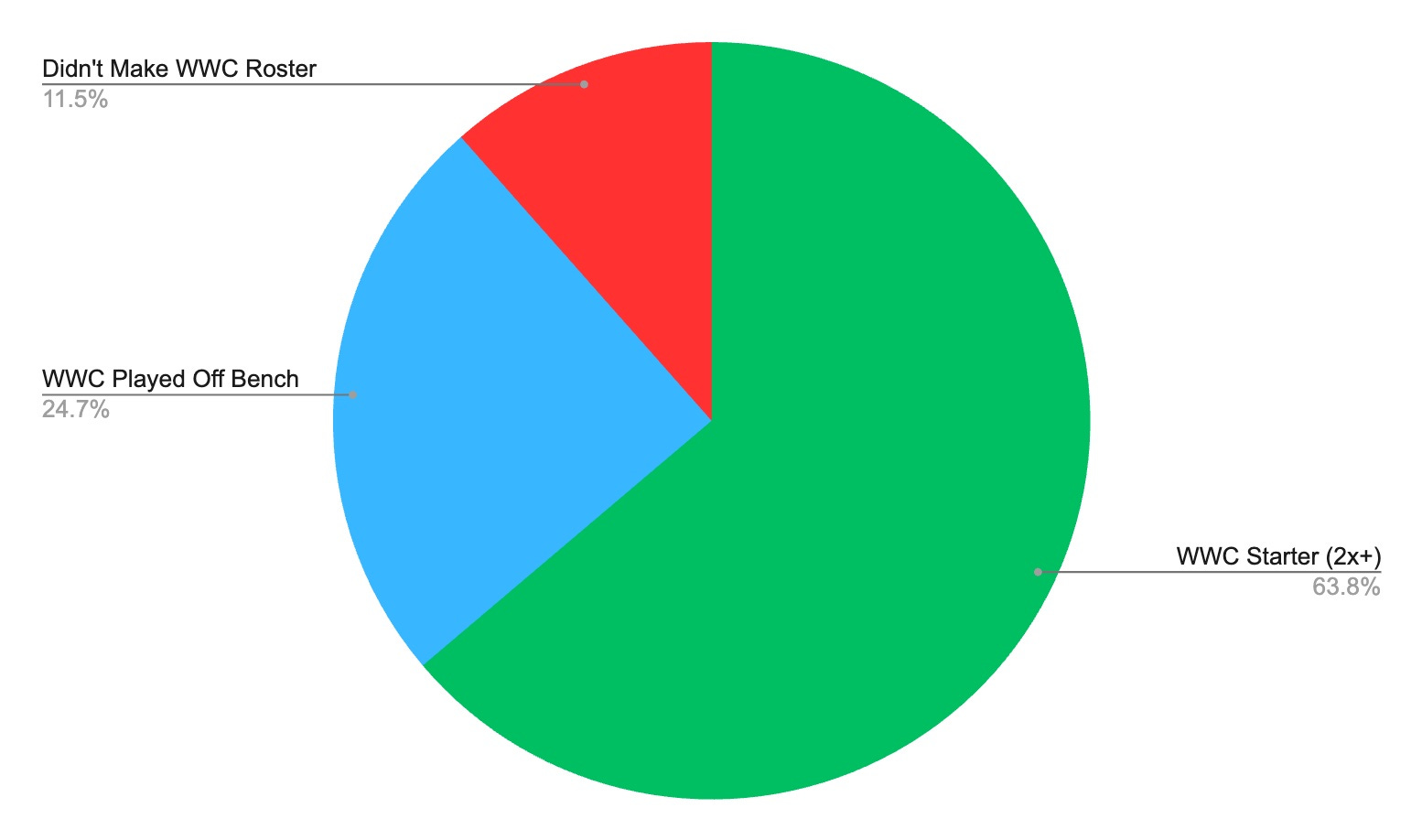
My Key Takeaways
- It’s crazy how the pie charts for the 1999 and 2019 teams are nearly the same.
- The 1999, 2007, 2011, 2015 and 2019 teams all saw minutes distributed during the build up to the World Cup in fairly similar ways among players who went on to start twice or more at the World Cup, primarily came off the bench at the World Cup, made the roster but didn’t play at the World Cup and those who didn’t make the World Cup roster.
- The 2003 and 2023 teams are the clear outliers.
Question 2
Were the players prepared during the cycle to play a specific role at the World Cup?
To evaluate this question, I calculated the difference in percent playing time for individual field players between the World Cup itself vs the build up to the tournament. The equation was simply:
Difference = % of available minutes played in the World Cup - % of available minutes played in the build up to the World Cup
Looking at the differences in field players’ playing time during the World Cup vs the build up to the World Cup speaks to whether these individual players had defined roles that held true in the preparation for the tournament as well as the tournament itself. Were individual field players ready to take on their World Cup roles based upon the role they played on the team in the build up to the tournament?
Once I calculated the field players’ differences in percent playing time, I graphed them for the all field players who made the World Cup roster plus however many field players didn’t make the World Cup roster until there were 30 total field players represented on the graph. (World Cup rosters expanded from 20 players in 1999 and 2003, to 21 players in 2007 and 2011, to 23 players in 2015 on.)
The colors of the bars on the graphs below continue to reflect the same categories that were applied to the pie charts above: Green for 2x World Cup starters, Blue for players who primarily came off the bench at the World Cup, Orange for players who saw no minutes at the World Cup, and Red for players who did not make the World Cup roster.
How to read these bar graphs with all examples from the 2023 team:
- X-Axis: Field players are listed in ranked order of minutes played in the build up to the World Cup with the player logging the most minutes on the far left (i.e. Alana Cook) and the player logging the least minutes on the far right (i.e. Savannah DeMelo).
- Y-Axis: The height of each field player’s bar indicates the difference between the percent of available minutes the player logged at the World Cup vs in the build up to the World Cup. If the player’s bar is above the x-axis, they played more minutes percentage wise in the World Cup than in the build up (i.e. Julie Ertz) and similarly, if the player’s bar is below the x-axis, they played less minutes percentage wise in the World Cup than in the build up to the tournament (i.e. Alana Cook). If a player’s bar is close to 0% (i.e. Emily Sonnett, Megan Rapinoe or Alyssa Thompson), they played a similar percentage of minutes available in both the World Cup and the build up to the tournament.
- As the World Cup is such a smaller sample of games (4 matches for the 2023 squad) vs the build up to the tournament (30 matches for the 2023 squad), some of this difference is expected. Due to this, I considered anything within a +/- range of 33% normal and the purple rectangular box drawn on top of the graph reflects this consideration.
- Notice how many individual field players saw a significant difference in their percent of available minutes played at the World Cup in comparison to the build up to the tournament, which is reflected by the bars that eclipse the purple rectangular box. (For the 2023 team, there are 10.)
2023 World Cup Cycle || Head Coach: Vlatko Andonovski || Round of 16
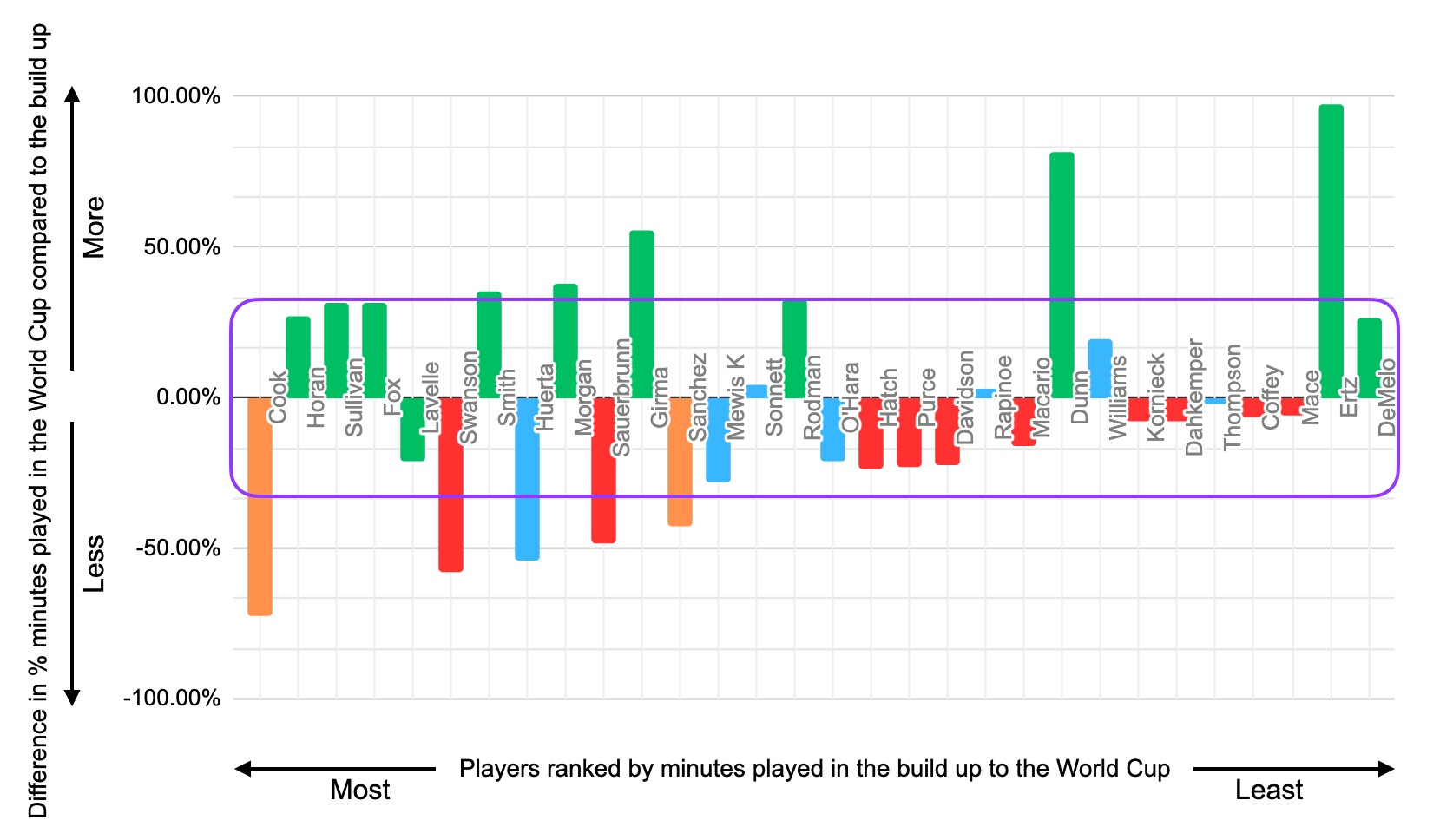
2019 World Cup Cycle || Head Coach: Jill Ellis || Champion
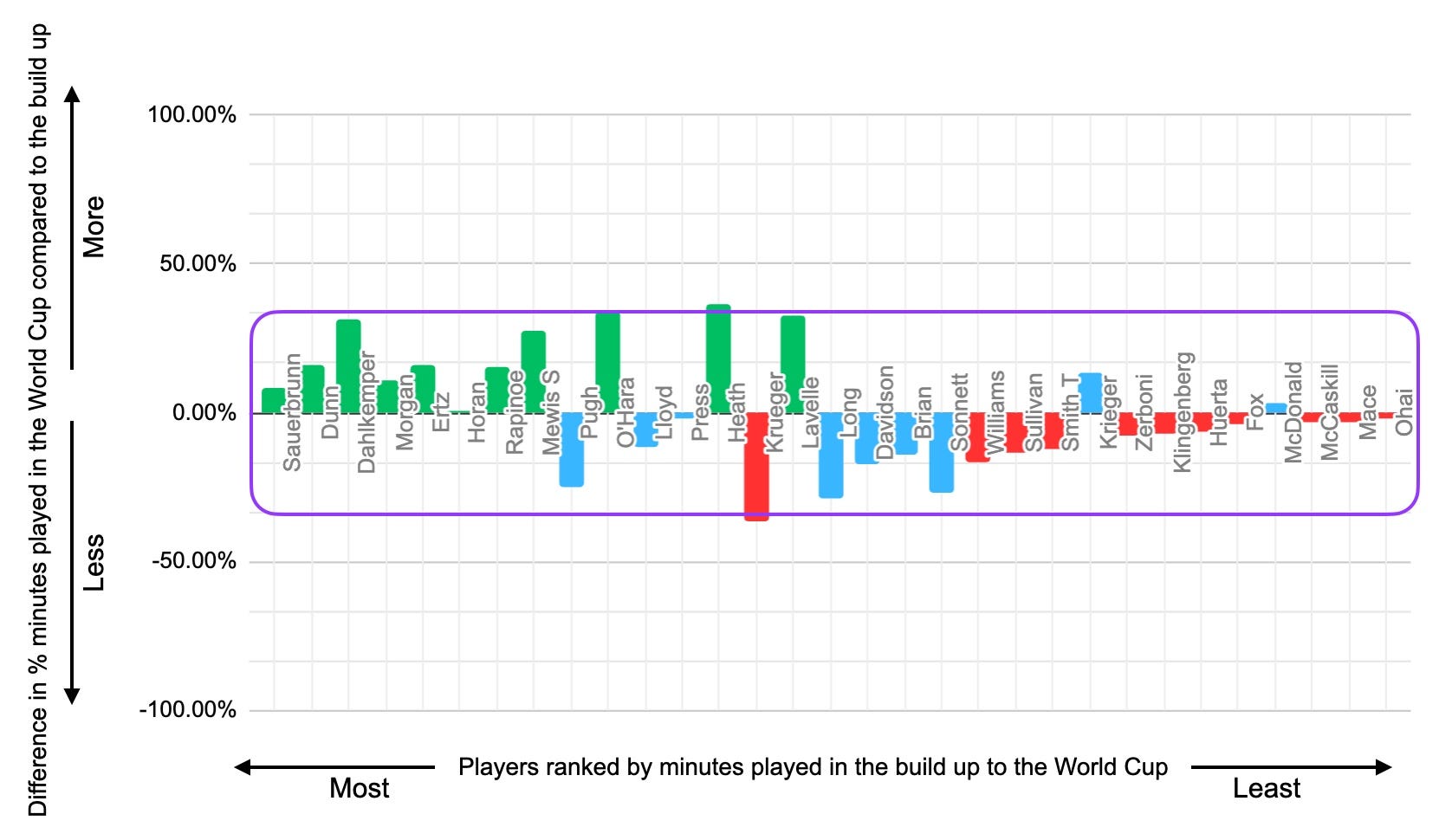
2015 World Cup Cycle || Head Coaches: Jill Ellis (April 10, 2014 onwards) & Tom Sermanni (2013 - April 6, 2014) || Champion
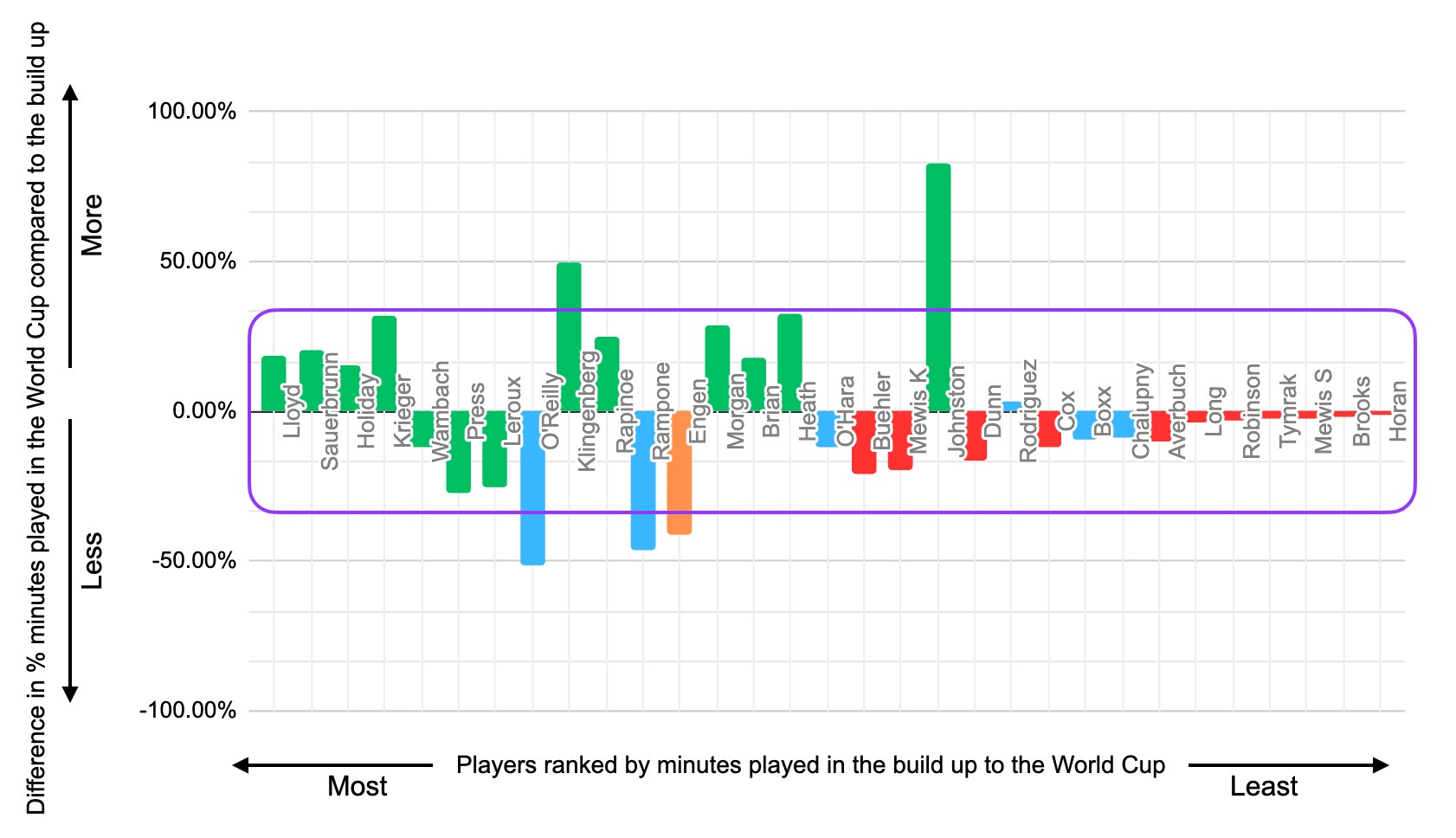
2011 World Cup Cycle || Head Coach: Pia Sundhage || Runner-Up
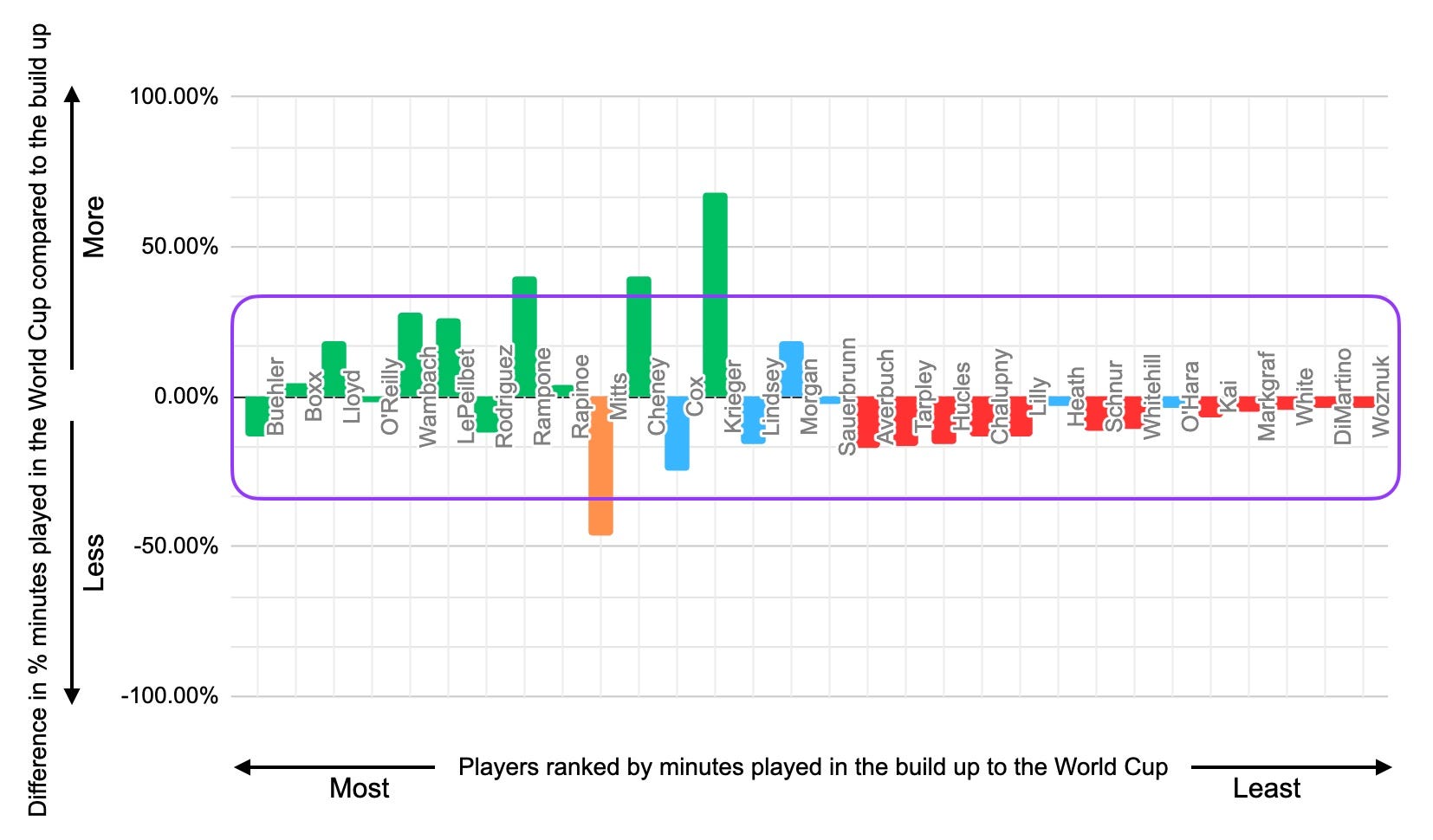
2007 World Cup Cycle || Head Coach: Greg Ryan || 3rd Place
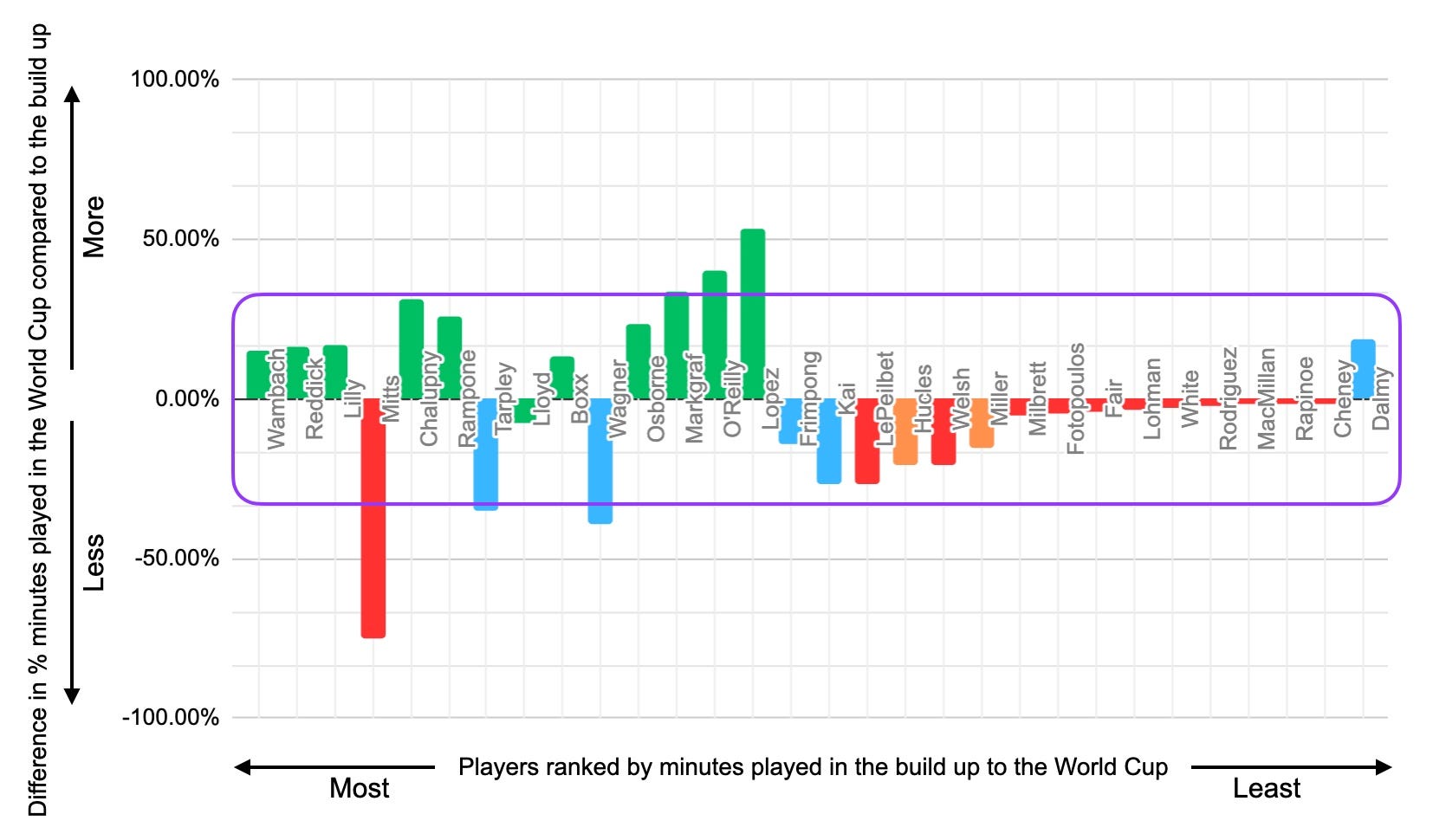
2003 World Cup Cycle || Head Coach: April Heinrichs || 3rd Place
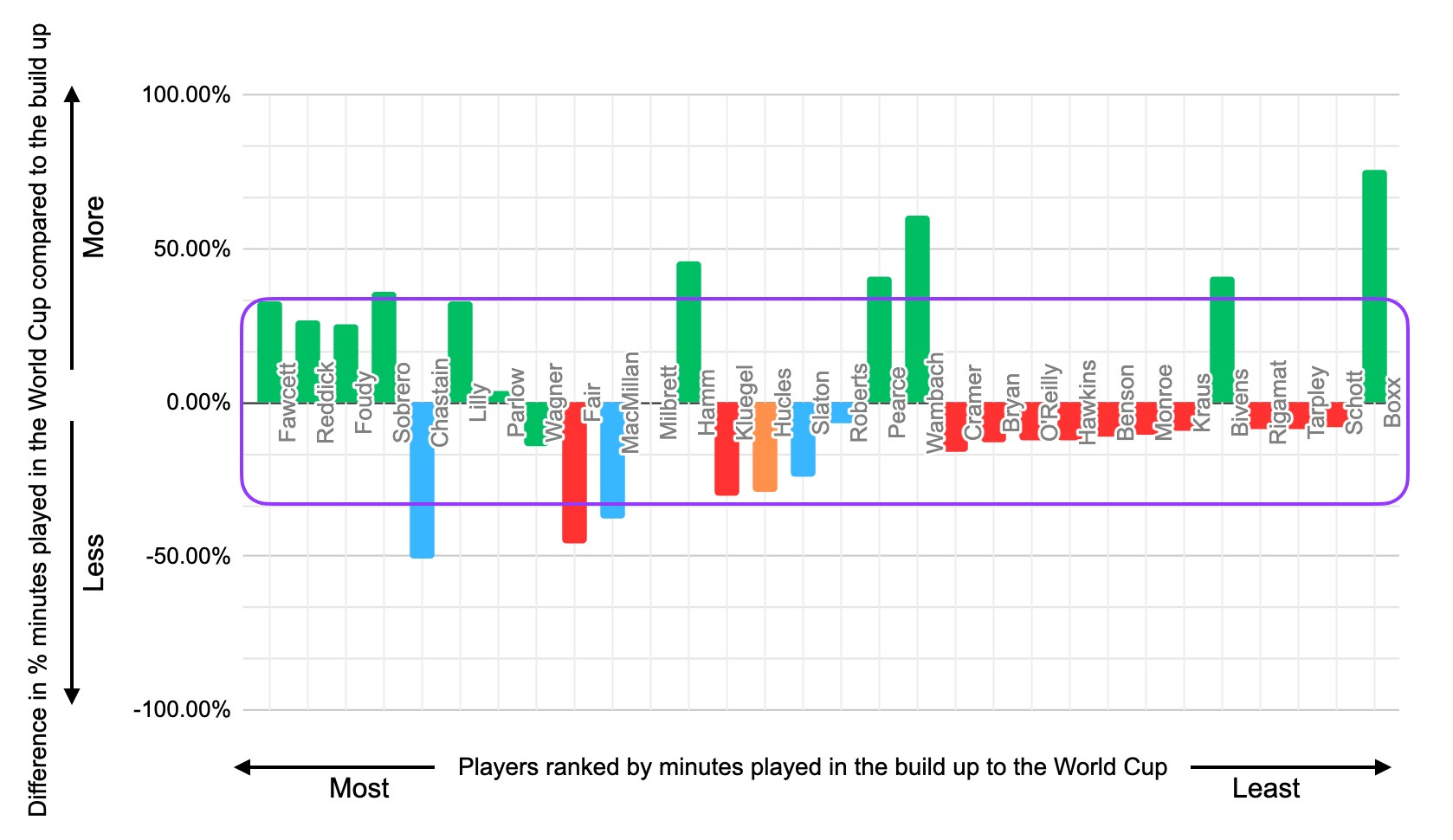
1999 World Cup Cycle || Head Coach: Tony DiCicco || Champion
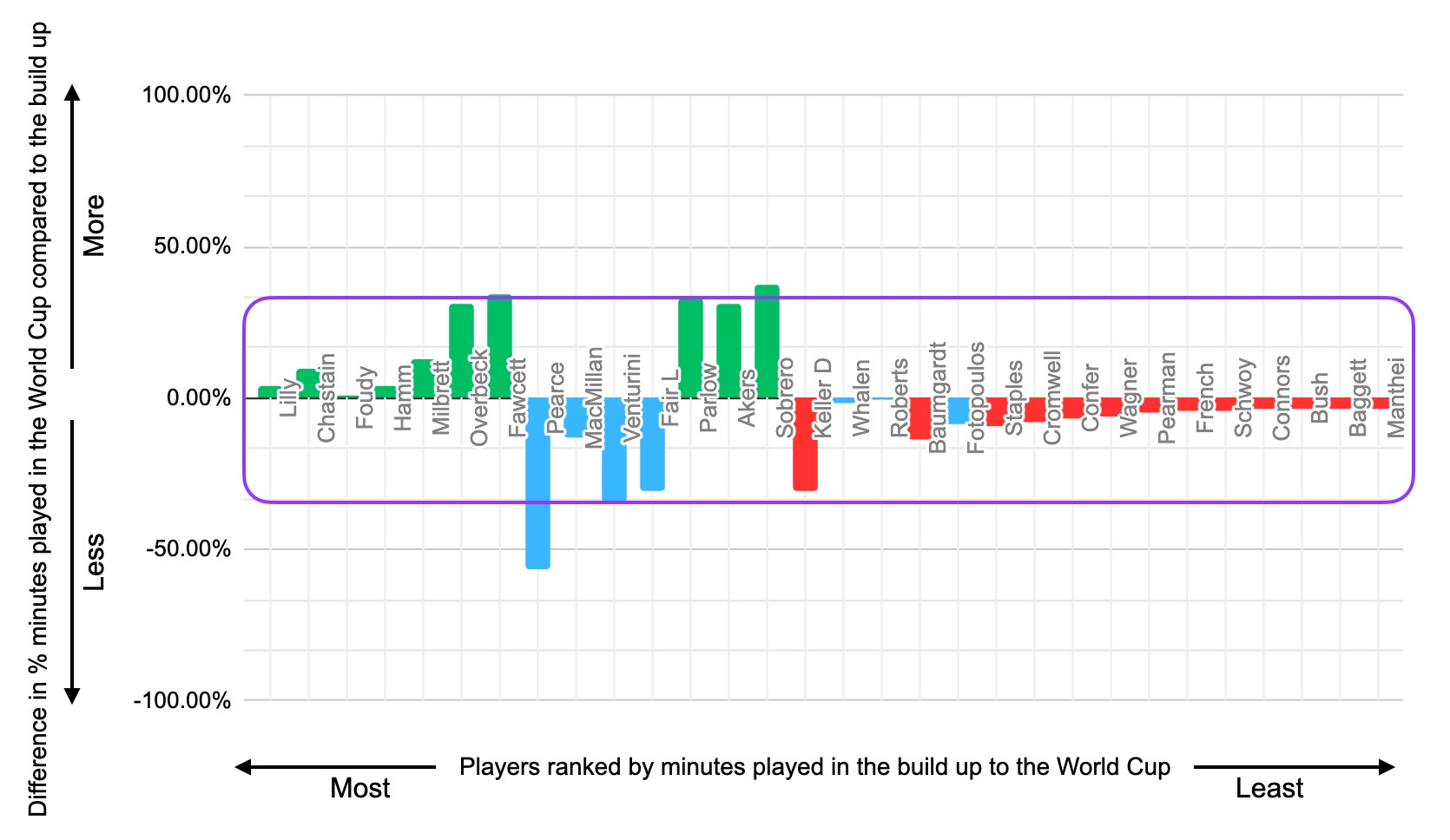
My Key Takeaways
- The 2023 and 2003 teams had the most difference in individual field player roles between the World Cup and the build up to the tournament. I do wonder if the investment in the game globally was the same for both tournaments if the 2003 team would have had a worse result (bronze) or if they still would have reached the semifinals due to having a core group of eight players who played together for the majority of the build up to the tournament, which will be seen in the next visualization.
- The rest of the graphs - 1999, 2007, 2011, 2015 & 2019 - show a minimal number of individual field players seeing a significant change in their role between the World Cup and the build up to the World Cup.
- Also note how the 2023 and 2003 teams were the only teams to see the players who would start twice or more at the World Cup spread across the entire length of the x-axis. This is due to several players who would start twice or more at those World Cups not being identified until close to the tournament and therefore earning less playing minutes in the build up to the World Cup. Meanwhile the rest of the graphs have all of the players who would start twice or more at the World Cup on the left side of the graph. The lone exception to this is Julie Johnston Ertz on the 2015 team as she emerged early in 2015 and therefore didn't log as many minutes in the build up to the tournament.
- Again, the 1999 and 2019 graphs are pretty similar.
- I’ve heard anecdotes from the 2019 team about how well prepared they were for the 2019 FIFA Women’s World Cup. This graph shows that the 2019 team was dialed. Only three players - Tobin Heath, Kelley O'Hara and Casey Short Krueger - just barely eclipse the purple box, which considers a +/- 33% difference in percent playing time between the World Cup and the build up to the tournament as within the realm of expectation given the different sample sizes in matches. To me, the 2019 graph speaks to a few things:
- 1) All the cards went this team's way - there were no major injuries or maternity leaves that caused field players to miss significant time during this cycle.
- 2) The coaching staff had a vision for this group of players.
- 3) The coaches as well as the players themselves nailed the execution of the plan throughout the cycle.
- Almost the exact same thing could be said for the 1999 team. The only difference being that Carla Overbeck and Joy Fawcett each missed the majority of 1997 while on maternity leave with Christie Pearce earning the 3rd most minutes on the National Team that year with them absent.
Question 3
When was the core of the World Cup team - defined as all field players who started at least twice during a World Cup - identified during the build up to the tournament? How many matches did the nucleus of the team have together to build an identity, chemistry and rhythm before the World Cup?
To visualize this, I looked at when each individual field player who earned two or more more starts at a World Cup - the players in green in the previous visuals - began taking on a core role on the team in the build up to the World Cup.
Of the three visualizations in this analysis, this one looking at when core players were identified has “art” involved. The guidelines I used to identify when a field player was identified as being a core member of the team heading into the World Cup were:
- The date I identified is the date on which the player began earning regular starts for the National Team during the build up to the World Cup. (It is possible the coaching staff identified the player as a core player well before this date but this was the date the player began and kept logging minutes as a core player in the build up to the World Cup.)
- If a player did not start regularly for the National Team at all for six or more months, I reset her clock.
- After six or more months of not starting regularly, I figure you have to come back in and prove yourself. Example: Kate Markgraf started all nine matches of 2005 but missed the first nine months of 2006 while pregnant with her first child. I recorded her start date of being a core player for the 2007 team as her first game back starting from maternity leave: Oct. 1, 2006, which was the 24th match of the build up to the World Cup.
- Giving up to six months of time before resetting a player's clock allows for minor injuries, temporary dips in form and coaching choices to work themselves out. Example: Lauren Cheney Holiday started five of the first seven matches of 2011 but then came off the bench for the next four matches over the course of three months prior to the 2011 FIFA Women's World Cup. I still kept her date of starting to be a core player as January 21, 2011, which was the 27th match of the build up to the World Cup. Cheney went on to start every match of the World Cup.
Notes about reading these bar graphs:
- Every National Team dating back to 1999 had 10 field players record two or more starts at the World Cup. Some graphs list more than 10 field players as more than 10 field players earned two or more starts at a World Cup. (The starting lineup shifted throughout the tournament.) For teams who had more than 10 field players start twice or more at the World Cup, I drew a dotted blue horizontal line on the graph to help visualize when that team met the 10-player mark. (The 2023 and 1999 teams won’t have a dotted blue horizontal line as just 10 field players started twice or more at each of those World Cups.)
- The green bars do not mean the player started or appeared in every match during the build up to the World Cup, simply that she was a core player and logging regular starts during this span. No player starts or appears in every match during the build up to the World Cup.
- Add 1 to the number indicated by the left edge of the green bar to determine the match number in which the field player began earning the majority of starts during the build up to the World Cup. This is due to the x-axis starting at 0 instead of 1.
- Vertical gray dotted lines indicate the start of the build up to the World Cup, calendar years and when the World Cup started.
- Pink boxes indicate when CONCACAF World Cup Qualifying occurred with World Cup Qualifying typically spanning 5 matches but with exceptions of 2 matches in 2006 and 7 matches in 2010 (due to that team needing a home-and-away playoff against Italy to secure a World Cup berth). Any player with a green bar inside of the pink box was identified as a core player by World Cup Qualifying.
- Note that the 1999 team won’t have a pink box as that team automatically qualified for the World Cup as its host. (The U.S. still went through World Cup Qualifying in 2002 for the 2003 World Cup, which it hosted, as the tournament site was moved to the U.S. three and a half months prior to the tournament due to a SARS outbreak in China.)
- Purple boxes indicate how many matches the entire core group of field players who went on to start twice at the World Cup had available to play together as a unit in the build up to the World Cup. The 2023 and 2003 graphs won’t have purple boxes due to at least one field player who started twice or more at the World Cup not being identified until the World Cup.
- The more white space on the lower left portion of a graph, the less time that core group of field players had together in the build up to the World Cup.
2023 World Cup Cycle || Head Coach: Vlatko Andonovski || Round of 16
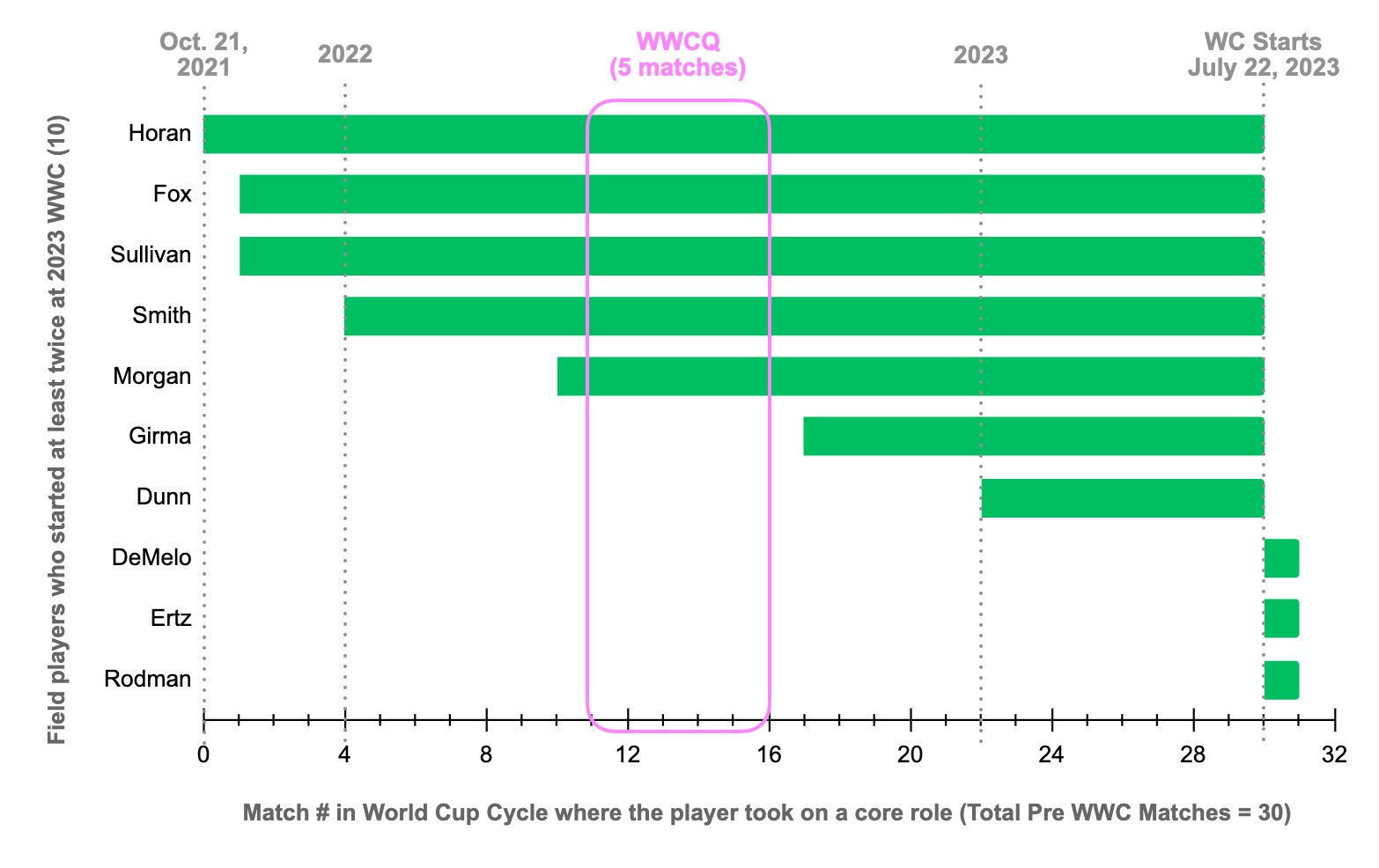
2019 World Cup Cycle || Head Coach: Jill Ellis || Champion
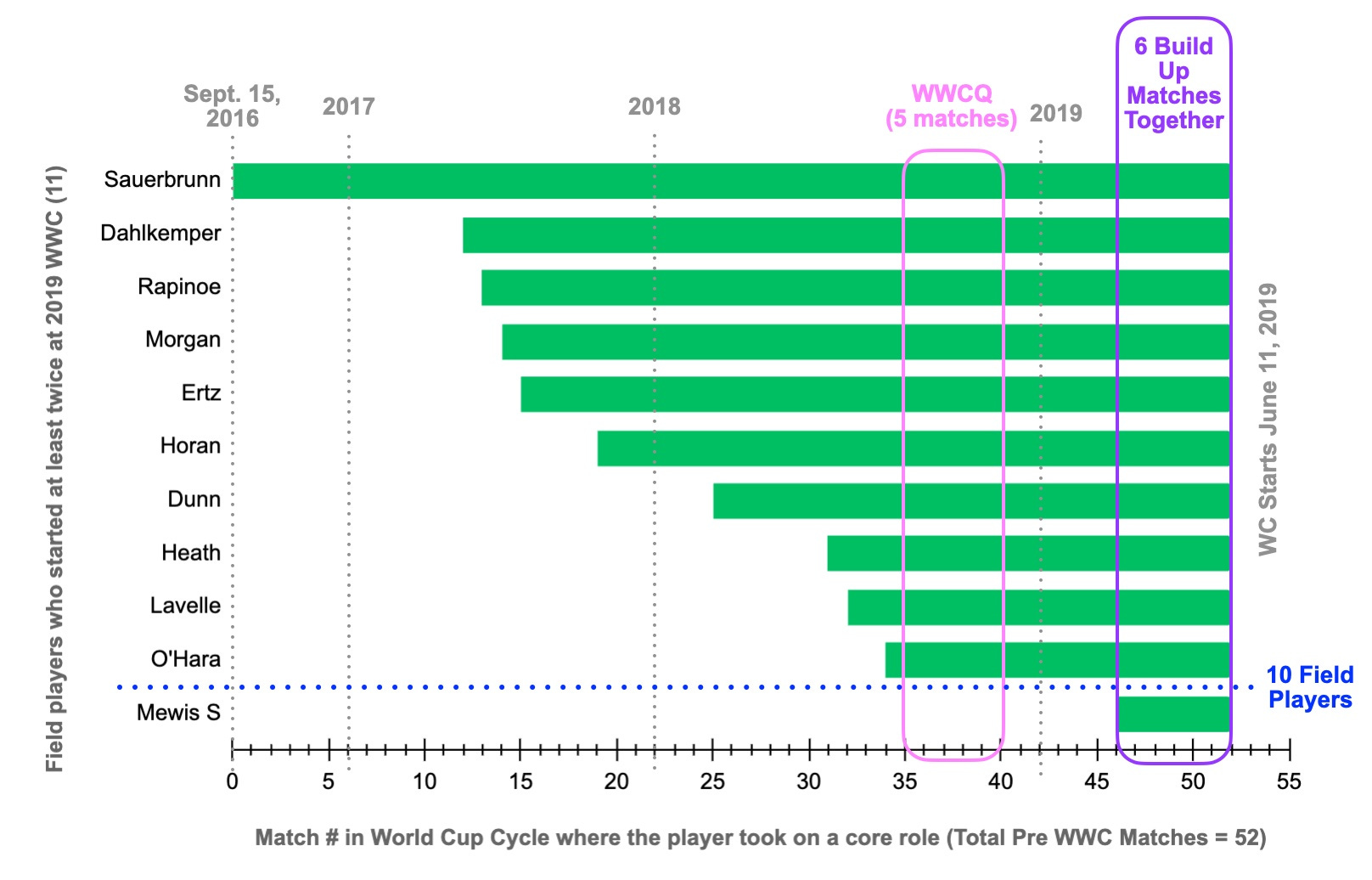
2015 World Cup Cycle || Head Coaches: Jill Ellis (April 10, 2014 onwards) & Tom Sermanni (2013 - April 6, 2014) || Champion
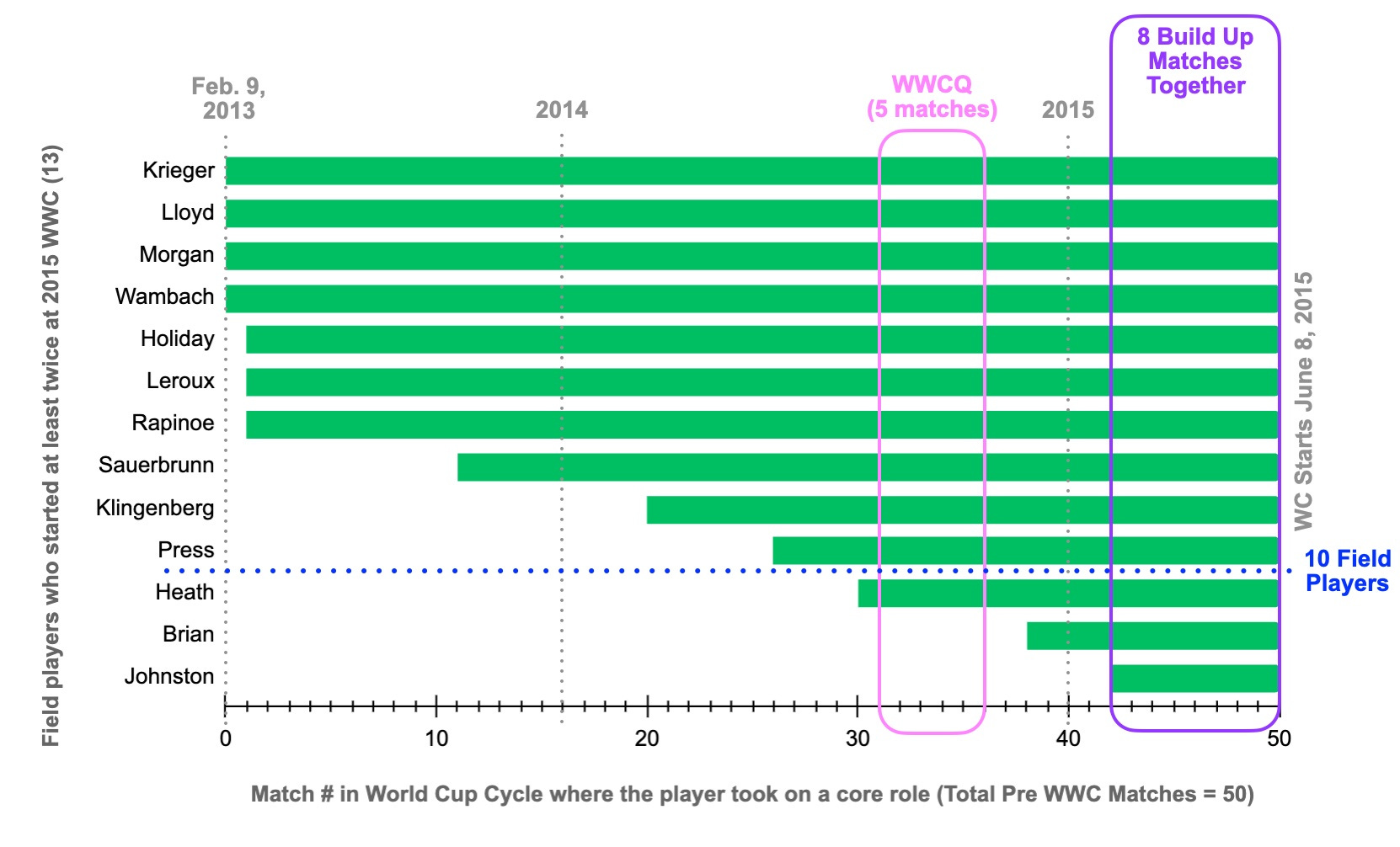
2011 World Cup Cycle || Head Coach: Pia Sundhage || Runner-Up
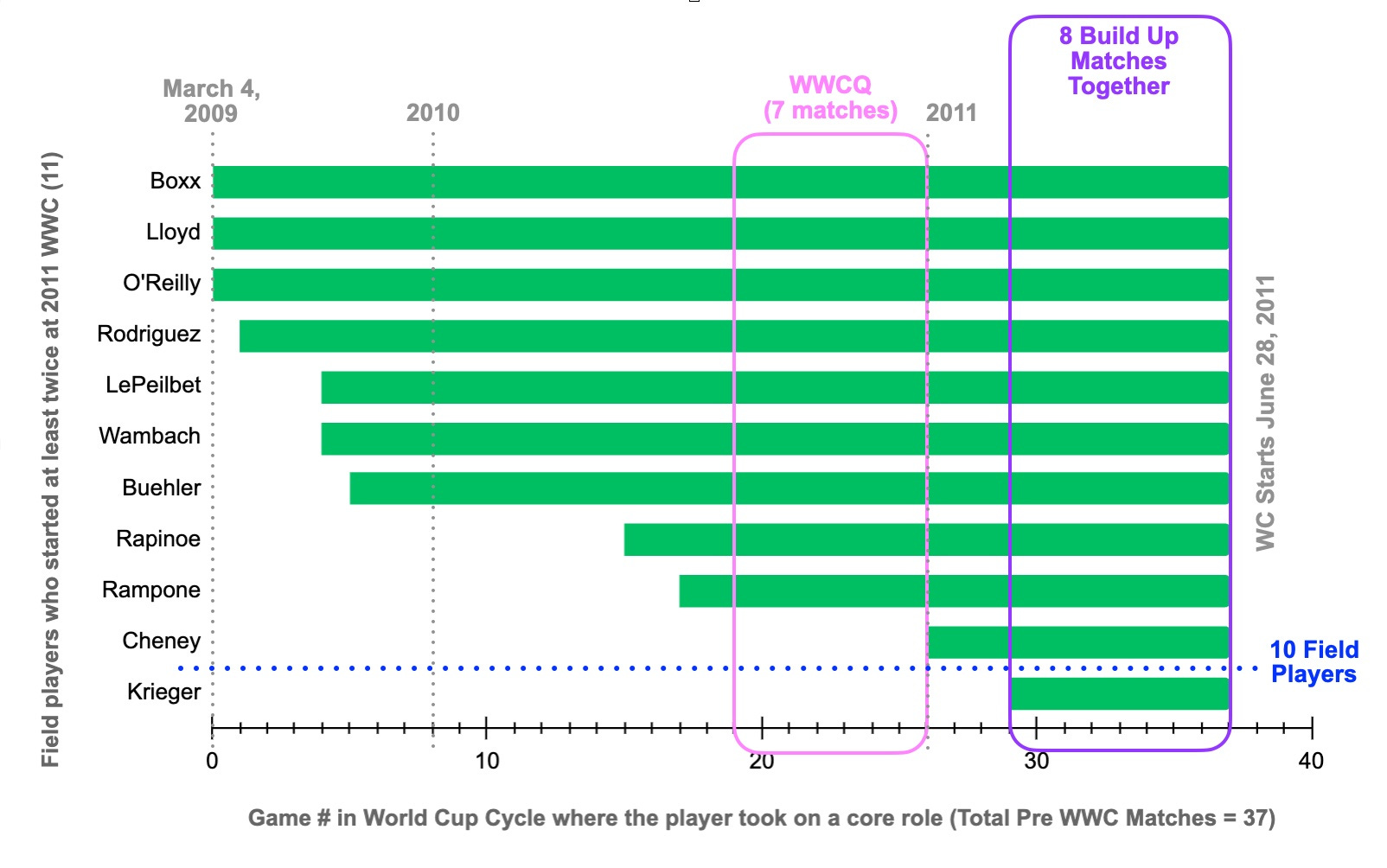
2007 World Cup Cycle || Head Coach: Greg Ryan || 3rd Place
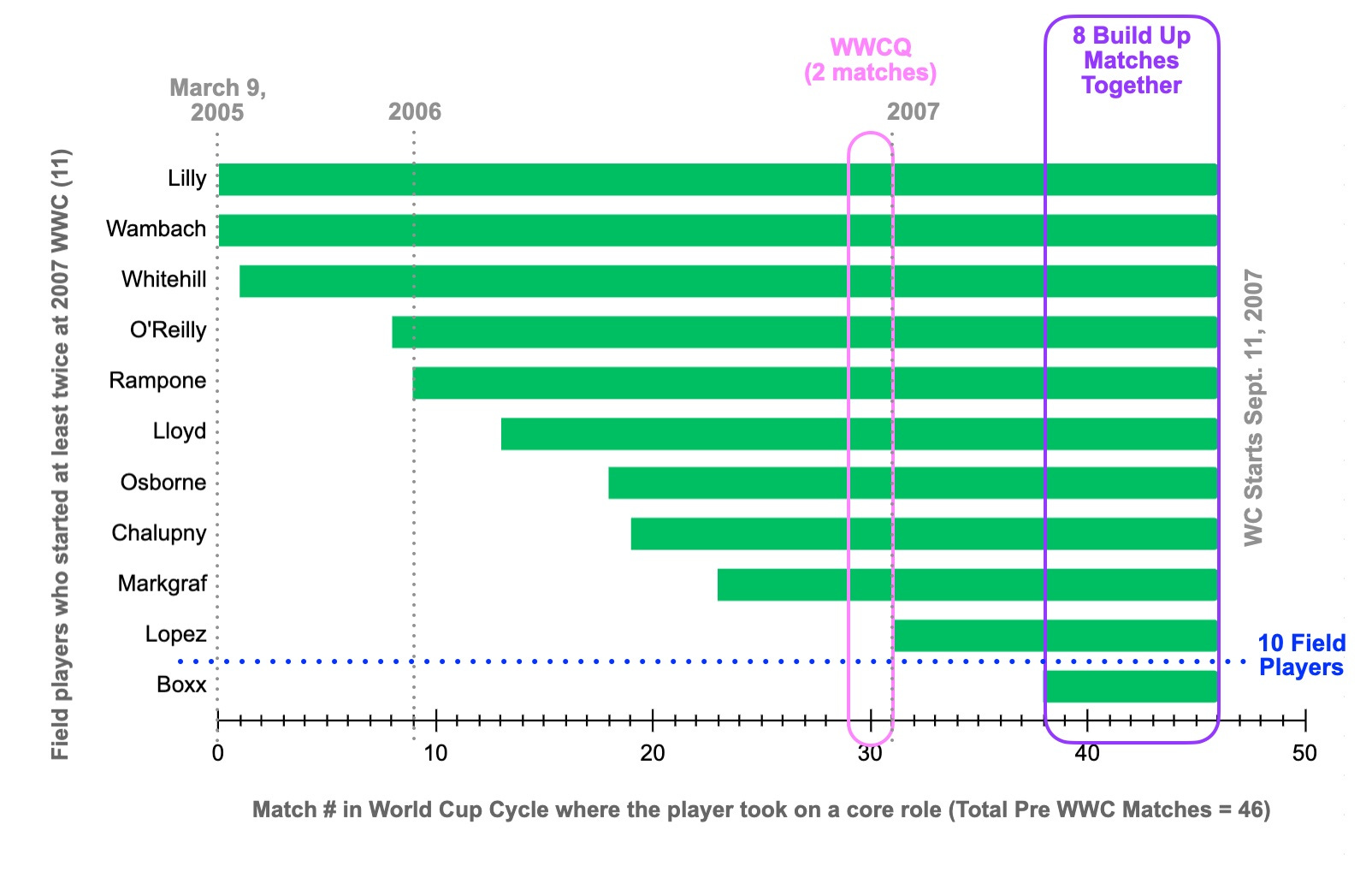
2003 World Cup Cycle || Head Coach: April Heinrichs || 3rd Place
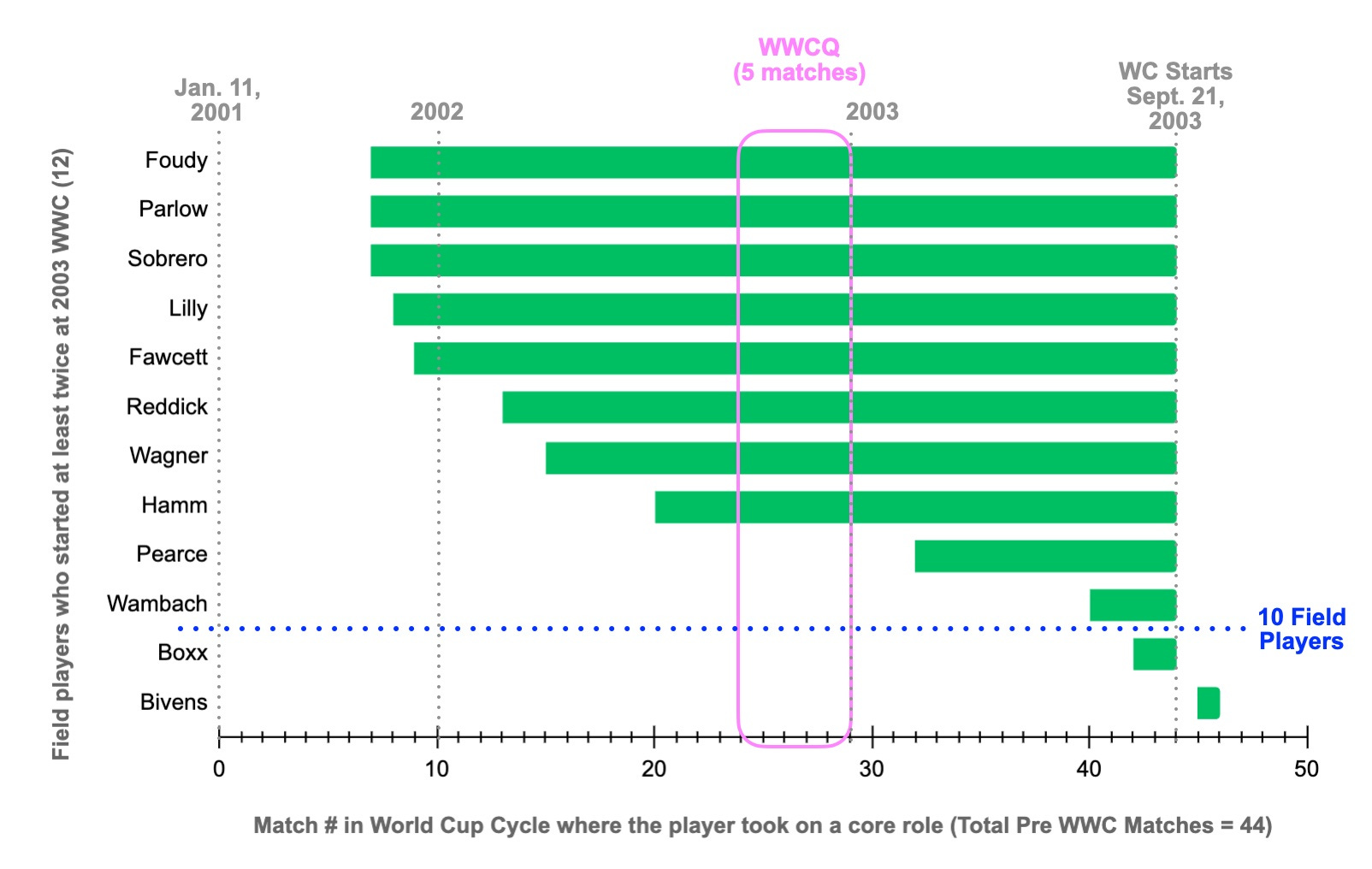
1999 World Cup Cycle || Head Coach: Tony DiCicco || Champion
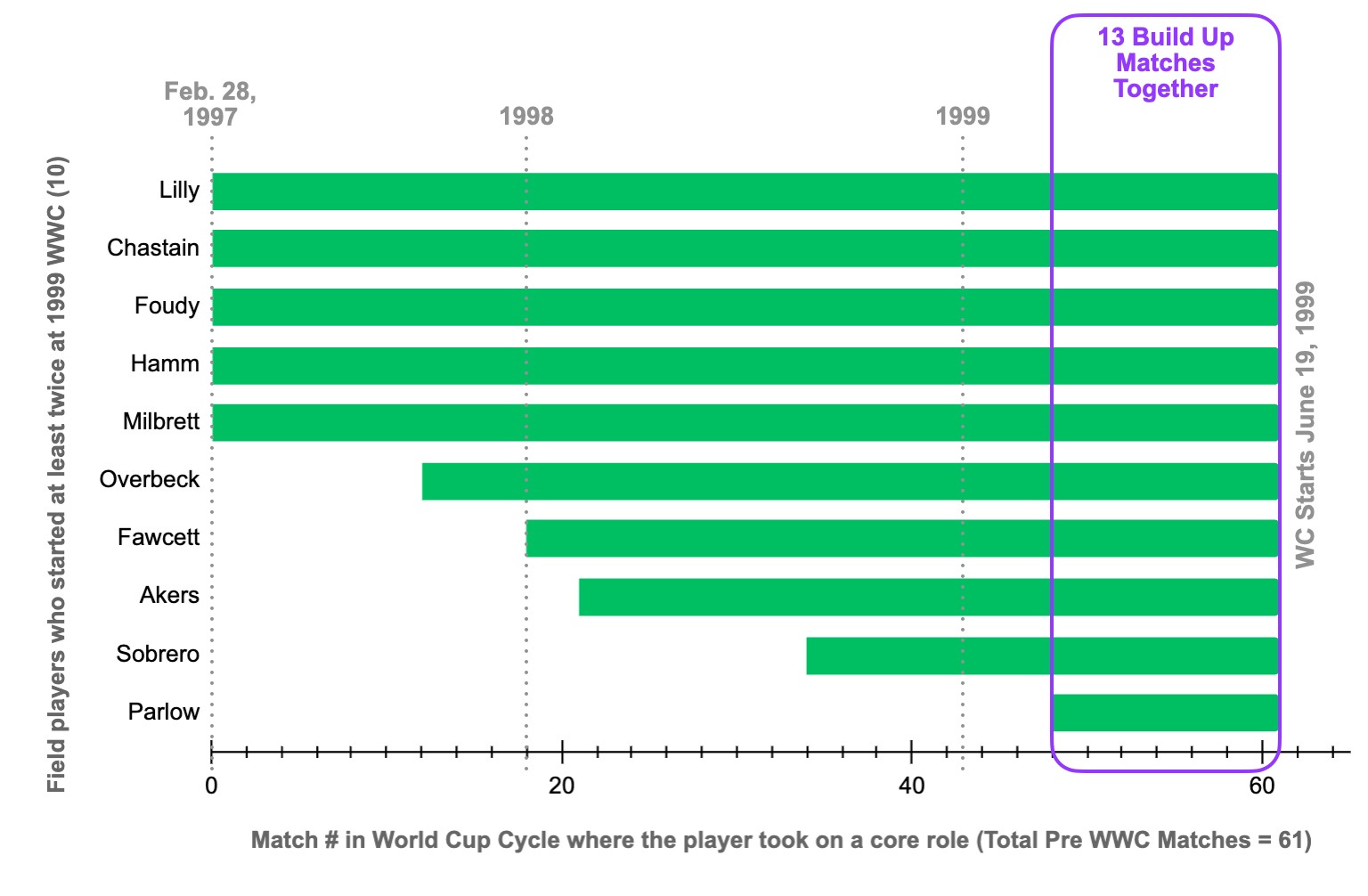
My Key Takeaways
- Neither the 2023 nor the 2003 teams had any matches together with the entire group of core field players who started twice or more at the World Cup prior to the tournament. But the 2003 team did meet the 10-player mark prior to the tournament - meaning 10 field players who would start twice or more at the World Cup had taken on a core role prior to that point.
- Both the 2023 and 2003 teams - for various reasons - attempted to insert three field players into their core group on the eve of / at the World Cup with unsatisfying results. Every other World Cup squad had their entire core group together for at least six matches prior to the tournament. The question still remains for me - can field players who suddenly emerge or return from injury or a maternity leave be inserted into the core group of a World Cup team on the eve of / at the tournament with successful results? Is there a limit to how many field players can be successfully inserted into the core group at the last minute? Can it be done and if so, how?
- How many matches each squad had together prior to the World Cup once 10 core field players were identified who would go on to start at least twice at the tournament:
- 2023: 0 matches
- 2019: 18 matches
- 2015: 24 matches
- 2011: 11 matches
- 2007: 15 matches
- 2003: 4 matches
- 1999: 13 matches
- How many core field players who would go on to start at least twice at the World Cup were identified by the midpoint of the build up to the tournament:
- 2023: 5 core field players
- 2019: 7 core field players
- 2015: 9 core field players
- 2011: 9 core field players
- 2007: 8 core field players (with Markgraf identified in the next match)
- 2003: 8 core field players
- 1999: 8 core field players
- The 2023 team had a number of factors contribute to their core player bar graph looking so different from every other World Cup squad dating back to 1999 including:
- The pandemic, which delayed the 2020 Tokyo Olympics to 2021, caused this squad to have one less year of build up time (likely 15-20 matches of preparation).
- Injuries. If Mal (Pugh) Swanson, Catrina Macario, Becky Sauerbrunn and Rose Lavelle had remained healthy and in theory each started at least twice at the World Cup, the 2023 team would have had 9 core field players identified by the midway point of the build up to the tournament and also for World Cup Qualifying.
- Coaching Decisions / Players returning from maternity leave.
- From the third match of the build up through the send off match, Alana Cook looked like a core field player who would go on to start at least twice at the World Cup. She did not play at all at the World Cup as Julie Ertz returned from maternity leave and regained her starting role at the World Cup.
- By the second half of 2022, Sofia Huerta looked like a core field player who would go on to start at least twice at the World Cup. But her playing time tapered off at the start of 2023 as Crystal Dunn fully returned from maternity leave and regained her starting role at outside back. Huerta played seven minutes at the World Cup.
- With Lavelle injuring her knee in April, Savannah DeMelo not yet emerging and on the strength of her own play, Ashley Sanchez earned five of eight possible starts prior to the World Cup in 2023, which would have made her a core player heading into the World Cup if she went on to start twice or more at the tournament. She didn't play at all at the World Cup.
Player Notes
By squad to help bring context to the above visualizations.
- 2023: Listed immediately above with additional commentary here.
- 2019:
- Casey Short Krueger earned the 3rd most minutes on the team in 2017 but then suffered an ankle injury while playing for the National Team in 2018. Her minutes tapered off upon her return to health in 2018, and she didn't play with the National Team at all in 2019 prior to the World Cup.
- Samantha Mewis started 16 matches for the National Team in 2017 before suffering a knee cartilage injury in November of that year which forced her to miss several months of playing time. She began playing a core role again with the National Team in March 2019.
- 2015:
- Julie Johnston Ertz emerged as a starting center back at the beginning of 2015. Prior to Ertz earning this starting role, Christie Rampone, Whitney Engen and Rachel Buehler Van Hollebeke were all in contention for the second starting center back spot beside Becky Sauerbrunn during this World Cup cycle.
- At the start of 2014, Meghan Klingenberg secured a starting outside back role beating out Kelley O'Hara, Crystal Dunn and Kristie Mewis - all four players were in contention for the role in 2013. Klingenberg played 50% of the available minutes in the build up to the 2015 World Cup but 100% of the tournament itself which is why her bar eclipses the purple box on the difference in % minutes played visualization.
- Heather O'Reilly, a starter at the 2007 and 2011 World Cups, started 13 of her 14 appearances in 2013. O'Reilly continued to start regularly through May 2014, but then began to see her minutes taper off as Christen Press, Tobin Heath and Morgan Brian Gautrat emerged during the build up to the 2015 World Cup.
- 2011:
- Christie Rampone missed the second half of 2009 and the first half of 2010 while pregnant with her second child.
- Heather Mitts regularly started at outside back for the National Team throughout 2009 and 2010 but saw her minutes taper off in 2011 as Ali Krieger emerged and earned the starting nod.
- Lauren Cheney Holiday emerged at the start of 2011 and went on to start all six of the National Team's matches at the 2011 World Cup. At the World Cup, she primarily took starts away from Megan Rapinoe who had started 17 of the last 22 National Team matches heading into the World Cup. Rapinoe only started twice at the 2011 tournament but still came off the bench to serve that epic cross to Abby Wambach in the last minute of extra time which sent the U.S. to a PK shootout versus Brazil in the quarterfinals (which they won).
- 2007:
- Heather Mitts, who started at outside back for the National Team throughout the build up to the 2007 World Cup, tore her ACL in a friendly against Canada four months before the tournament began. With Mitts out, Stephanie Lopez Cox earned the start at outside back at the 2007 World Cup.
- Christie Rampone missed 2005 while pregnant with her first child and Kate Markgraf likewise missed the first 9 months of 2006 while also pregnant with her first child.
- Shannon Boxx, who started for the National Team at holding midfielder at the 2003 World Cup, missed the second half of 2006 plus the first four matches of 2007 while recovering from a pair of surgeries - one to repair torn cartilage in her right hip, the other for torn medial collateral ligaments in her knee. She regained her starting role in April 2007.
- With Boxx absent for an extended period, Leslie Osborne emerged at holding midfielder. In the rest of the midfield, Lori Chalupny emerged and Heather O'Reilly continued to emerge following her super sub role at the 2004 Athens Olympics as both players earned starting roles. With Chalupny and O'Reilly starting in midfield, Lindsay Tarpley and Aly Wagner - who both started at the 2004 Athens Olympics - saw their minutes decline as the 2007 World Cup neared.
- 2003:
- With the first women's professional soccer league in the U.S. - the Women's United Soccer Association (WUSA) - starting in 2001, the National Team roster was composed of a "B squad" for its first six matches of 2001 as the players who regularly competed with the National Team opted to focus on their new club teams.
- Mia Hamm suffered a knee injury in late 2001 that kept her away from the National Team through the first half of 2002.
- Christie Pearce Rampone tore her ACL in late 2001 and didn't return to the National Team until early 2003.
- Lorrie Fair earned playing time in midfield throughout the build up to the 2003 World Cup, but missed a spot on the roster as Shannon Boxx, Angela Hucles and Aly Wagner emerged and Tiffany Roberts re-emerged (after a two-year hiatus) during the cycle.
- Shannon MacMillan, who earned the 5th most minutes on the team in 2002, tore her ACL in a WUSA match four months before the 2003 World Cup began but returned to come off the bench at the tournament.
- Brandi Chastain, who likely would have started throughout the tournament, broke her right foot during the first half of the National Team's first 2003 World Cup match. Catherine Reddick Whitehill came off the bench to start the rest of the tournament.
- The WUSA, which folded days before the 2003 World Cup began, was credited with helping Abby Wambach, Shannon Boxx and Kylie Bivens - each of whom started at least twice at the tournament - emerge with the National Team right before the World Cup began.
- 1999:
- Carla Overbeck and Joy Fawcett both missed much of 1997 while pregnant.
- With Overbeck and Fawcett both absent for much of 1997, Christie Pearce Rampone earned the 3rd most minutes on the team that year. But as Kate Sobrero emerged during the course of 1998 and into 1999, Pearce's minutes tapered off.
- Due to Chronic Fatigue Syndrome, Michelle Akers minutes had to be monitored. Due to this plus one of her knees needing a third reconstructive surgery following the 1996 Atlanta Olympics, she was limited to just two matches in 1997. As she ramped back up throughout the build up to the 1999 World Cup, Tisha Venturini saw her starting opportunities and minutes reduce.
- Cindy Parlow earned a starting role on the forward line in 1999 after completing her collegiate career at the University of North Carolina.
Thoughts, questions or ideas about this analysis? Email me at contact@womenssportsreview.com.
